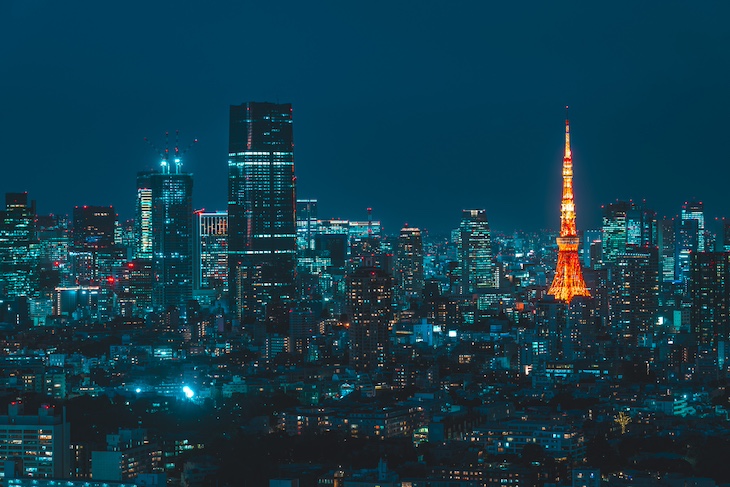In a move that sounds like something out of the new Francis Ford Coppola film Megalopolis, the Japanese government has announced that it will build a 300-mile conveyer belt for trade to link Tokyo and Osaka. The ‘Auto-flow Road’ which is projected to be the first of many such arteries linking Japan, will consist of conveyer belts either in tunnels beneath major roads or on tracks alongside the hard shoulder, or perhaps even both.
The image of the country as a super-efficient high tech deadline meeting superpower probably no longer
Pallets holding up to ton of cargo each will be transported on the constantly moving treadmill. The scheme, the brainchild of boffins at the Ministry of Land, Infrastructure, Transport and Tourism is projected to carry as much freight as could be delivered by 25,000 drivers, speedily, seamlessly and all at the touch of a button.
It all sounds rather fantastical, but the ministry has pointed out that such freight conveyer belts are in operation already, and not just in airports. There is a 23 km one at Torigatayama limestone mine in Kochi prefecture and a 100 km system in the western Sahara transporting phosphate.
The proposed Osaka-Tokyo link is on another scale altogether though and, pointedly, no firm completion date or estimated cost has been announced. The first would seem to be anyone’s guess, and the latter is clearly astronomical. The Yomiuri newspaper had a go at figuring out the numbers and came up with 508 million US dollars for every 10 km stretch. For the whole thing… well, do the math.
The first question this announcement might provoke is why bother? Specifically, why can’t the Japanese transport freight on the roads the country already has – which are rather good by the way? Why the need for a gigantic national debt straining super project that makes HS2 look like a mere bagatelle?
The answer is largely, manpower. One of Japan’s suite of looming disasters is a cargo crisis. The National Research Institute has estimated that there will be a 36 per cent shortfall of lorry drivers by 2030 with rural regions the worst hit. One study found that some remote areas would be facing a 41 per cent driver shortage within six years. This would not only deprive certain communities of the timely delivery of essential supplies but likely exacerbate one of Japan’s perennial problems – rural flight and the slow death of the countryside.
So…yet more people in the cities competing for jobs, more people living in tiny apartments, existing only for their work, without the living space or perhaps the energy to settle down and raise a family and do something about the greatest crisis of them all – the shrinking population. Japan, according to the doomsters, might one day resemble the America of Judge Dredd, with two massive mega-cities (Tokyo and Osaka presumably) and the rest a rewilded wilderness.
Clearly something must be done, but there is plenty of cynicism about this project already. Of the numerous huge obstacles, the most salient would appear to be cost. Where is the money coming from exactly? The Japanese government’s ambitious plans for massively increased military spending were met with a chorus of ‘we can’t afford it’ (and nothing much has happened) and the same will be true of this mega-project.
Even if the money is found somewhere there are doubts about whether the project is even feasible. Japan’s international reputation tends to lag several decades behind the reality and the image of the country as a super-efficient high tech deadline meeting superpower probably no longer obtains.
That reputation originated in the white heat of the early 1960s when Japan was desperate to advance and be re-admitted to the family of nations after the second world war. That urgency, spurred on by the era-defining 1964 Tokyo Olympics, led to the transformation of Tokyo and such marvels as the still futuristic looking and still superb Shinkansen train.
But, that was quite a long time ago. Large scale infrastructure projects recently haven’t been quite so impressive. A conspicuous recent failure has been the proposed Maglev high speed train line between – you guessed it – Tokyo and Osaka which was due to open in just three years’ time but is now slated for 2034. Many of the large-scale solar panel farms that dot the countryside are believed to be dangerous too. And then there was Fukushima…
And many will wonder if this isn’t anyway just some massive make-work scheme for the planners, engineers, and former bureaucrats parachuted into comfortable directorships (the so called ‘fallen from heaven’). This is the sort of thing that Alex Kerr wrote about in Dogs and Demons his seminal analysis of Japanese institutional corruption and the squandering of public resources by the political class aided abetted by Japan’s version of the blob.
Kerr lamented the despoliation of the countryside and coast by the almost obsessive building of largely unnecessary dams and the siting of ugly and largely unnecessary tetrapods in hugely profitable public works projects whose only real beneficiaries were those on the payroll.
Maybe this will be another of those.
Or maybe not. Less cynically, this might even be the real thing, a bold imaginative solution to a real and pressing problem, the kind of positive and inspiring project which in its full nationwide flowering may breathe new life into seemingly moribund communities.
As they say in Japan ‘jikan ga kakeba wakaru’ – time will tell.








Comments